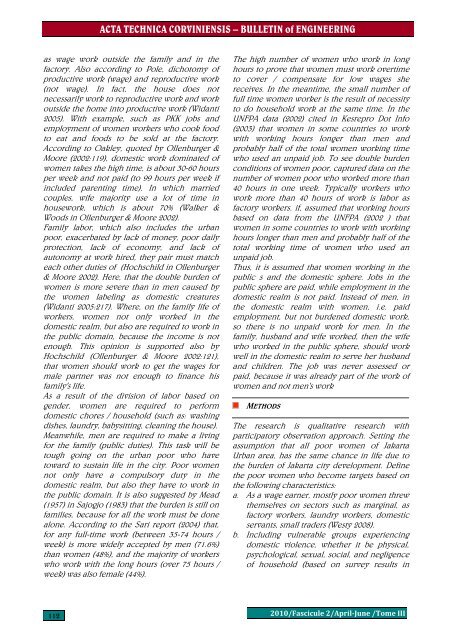ACTA TECHNICA CORVINIENSIS - Bulletin of Engineering
ACTA TECHNICA CORVINIENSIS - Bulletin of Engineering
ACTA TECHNICA CORVINIENSIS - Bulletin of Engineering
- No tags were found...
You also want an ePaper? Increase the reach of your titles
YUMPU automatically turns print PDFs into web optimized ePapers that Google loves.
<strong>ACTA</strong> <strong>TECHNICA</strong> <strong>CORVINIENSIS</strong> – BULLETIN <strong>of</strong> ENGINEERINGas wage work outside the family and in thefactory. Also according to Pole, dichotomy <strong>of</strong>productive work (wage) and reproductive work(not wage). In fact, the house does notnecessarily work to reproductive work and workoutside the home into productive work (Widanti2005). With example, such as PKK jobs andemployment <strong>of</strong> women workers who cook foodto eat and foods to be sold at the factory.According to Oakley, quoted by Ollenburger &Moore (2002:119), domestic work dominated <strong>of</strong>women takes the high time, is about 30-60 hoursper week and not paid (to 99 hours per week ifincluded parenting time). In which marriedcouples, wife majority use a lot <strong>of</strong> time inhousework, which is about 70% (Walker &Woods in Ollenburger & Moore 2002).Family labor, which also includes the urbanpoor, exacerbated by lack <strong>of</strong> money, poor dailyprotection, lack <strong>of</strong> economy, and lack <strong>of</strong>autonomy at work hired, they pair must matcheach other duties <strong>of</strong> (Hochschild in Ollenburger& Moore 2002). Here, that the double burden <strong>of</strong>women is more severe than in men caused bythe women labeling as domestic creatures(Widanti 2005:217). Where, on the family life <strong>of</strong>workers, women not only worked in thedomestic realm, but also are required to work inthe public domain, because the income is notenough. This opinion is supported also byHochschild (Ollenburger & Moore 2002:121),that women should work to get the wages formale partner was not enough to finance hisfamily's life.As a result <strong>of</strong> the division <strong>of</strong> labor based ongender, women are required to performdomestic chores / household (such as: washingdishes, laundry, babysitting, cleaning the house).Meanwhile, men are required to make a livingfor the family (public duties). This task will betough going on the urban poor who havetoward to sustain life in the city. Poor womennot only have a compulsory duty in thedomestic realm, but also they have to work inthe public domain. It is also suggested by Mead(1957) in Sajogjo (1983) that the burden is still onfamilies, because for all the work must be donealone. According to the Sari report (2004) that,for any full-time work (between 35-74 hours /week) is more widely accepted by men (71.6%)than women (48%), and the majority <strong>of</strong> workerswho work with the long hours (over 75 hours /week) was also female (44%).The high number <strong>of</strong> women who work in longhours to prove that women must work overtimeto cover / compensate for low wages shereceives. In the meantime, the small number <strong>of</strong>full time women worker is the result <strong>of</strong> necessityto do household work at the same time. In theUNFPA data (2002) cited in Kesrepro Dot Info(2003) that women in some countries to workwith working hours longer than men andprobably half <strong>of</strong> the total women working timewho used an unpaid job. To see double burdenconditions <strong>of</strong> women poor, captured data on thenumber <strong>of</strong> women poor who worked more than40 hours in one week. Typically workers whowork more than 40 hours <strong>of</strong> work is labor asfactory workers. if, assumed that working hoursbased on data from the UNFPA (2002 ) thatwomen in some countries to work with workinghours longer than men and probably half <strong>of</strong> thetotal working time <strong>of</strong> women who used anunpaid job.Thus, it is assumed that women working in thepublic s and the domestic sphere. Jobs in thepublic sphere are paid, while employment in thedomestic realm is not paid. Instead <strong>of</strong> men, inthe domestic realm with women, i.e. paidemployment, but not burdened domestic work,so there is no unpaid work for men. In thefamily, husband and wife worked, then the wifewho worked in the public sphere, should workwell in the domestic realm to serve her husbandand children. The job was never assessed orpaid, because it was already part <strong>of</strong> the work <strong>of</strong>women and not men's workMETHODSThe research is qualitative research withparticipatory observation approach. Setting theassumption that all poor women <strong>of</strong> JakartaUrban area, has the same chance in life due tothe burden <strong>of</strong> Jakarta city development. Definethe poor women who become targets based onthe following characteristics:a. As a wage earner, mostly poor women threwthemselves on sectors such as marginal, asfactory workers, laundry workers, domesticservants, small traders (Westy 2008).b. Including vulnerable groups experiencingdomestic violence, whether it be physical,psychological, sexual, social, and negligence<strong>of</strong> household (based on survey results in1122010/Fascicule 2/AprilJune /Tome III
















